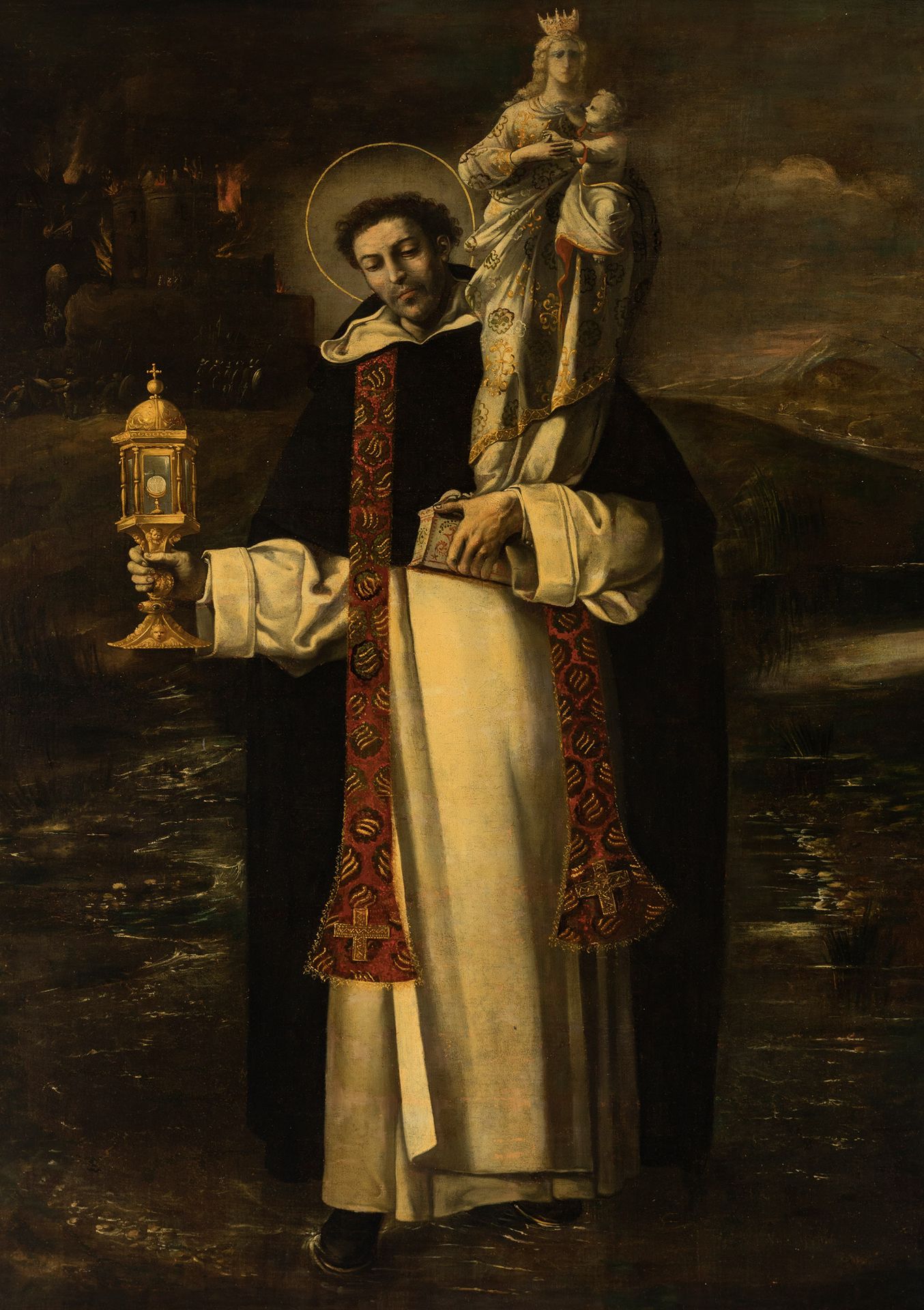Description
Andalusian school; second half of the 17th century. "Saint Hyacinth of Krakow". Oil on canvas. It has a 20th century frame. Measurements: 128 x 89 cm; 153 x 114 cm (frame). Saint Hyacinth of Krakow was a Polish Dominican priest and missionary who worked to reform the women's monasteries in his native Poland. He was a Doctor of Sacred Studies, educated in Paris and Bologna. Called the "Apostle of the North", while in Rome, he witnessed a miracle performed by Dominic of Osma and became a Dominican friar. In 1219, Pope Honorius III invited Dominic and his followers to settle in the ancient Roman basilica of Santa Sabina, which they did in early 1220. Tradition holds that he evangelised in Sweden, Norway, Denmark, Prussia, Scotland, Russia, Turkey and Greece. One of the greatest miracles attributed to Hyacinth occurred during a Mongol attack on Kiev. As the friars were preparing to flee from the invading forces, Hyacinth went to save the ciborium containing the Blessed Sacrament from the tabernacle of the monastery chapel, when he heard the voice of Mary, the mother of Jesus, asking him to take it too. Hyacinth picked up the large stone statue of Mary, as well as the ciborium. He was easily able to carry both, despite the fact that the statue weighed much more than he could normally lift. Thus he saved them both. For this reason, he is usually shown holding a monstrance and a statue of Mary. The 17th century saw the arrival of the Baroque in the Andalusian school, with the triumph of naturalism over Mannerist idealism, loose workmanship and many other aesthetic liberties. At this time the school reached its greatest splendour, both in terms of the quality of its works and the primordial status of Sevillian Baroque painting. Thus, during the transition to the Baroque period, we find Juan del Castillo, Antonio Mohedano and Francisco Herrera el Viejo, whose works already display the rapid brushstrokes and crude realism of the style, and Juan de Roelas, who introduced Venetian colourism. The middle of the century saw the fullness of the period, with figures such as Zurbarán, a young Alonso Cano and Velázquez. Finally, in the last third of the century we find Murillo and Valdés Leal, founders in 1660 of an Academy where many of the painters active during the first quarter of the 18th century were trained, such as Meneses Osorio, Sebastián Gómez, Lucas Valdés and others.
77
Andalusian school; second half of the 17th century. "Saint Hyacinth of Krakow". Oil on canvas. It has a 20th century frame. Measurements: 128 x 89 cm; 153 x 114 cm (frame). Saint Hyacinth of Krakow was a Polish Dominican priest and missionary who worked to reform the women's monasteries in his native Poland. He was a Doctor of Sacred Studies, educated in Paris and Bologna. Called the "Apostle of the North", while in Rome, he witnessed a miracle performed by Dominic of Osma and became a Dominican friar. In 1219, Pope Honorius III invited Dominic and his followers to settle in the ancient Roman basilica of Santa Sabina, which they did in early 1220. Tradition holds that he evangelised in Sweden, Norway, Denmark, Prussia, Scotland, Russia, Turkey and Greece. One of the greatest miracles attributed to Hyacinth occurred during a Mongol attack on Kiev. As the friars were preparing to flee from the invading forces, Hyacinth went to save the ciborium containing the Blessed Sacrament from the tabernacle of the monastery chapel, when he heard the voice of Mary, the mother of Jesus, asking him to take it too. Hyacinth picked up the large stone statue of Mary, as well as the ciborium. He was easily able to carry both, despite the fact that the statue weighed much more than he could normally lift. Thus he saved them both. For this reason, he is usually shown holding a monstrance and a statue of Mary. The 17th century saw the arrival of the Baroque in the Andalusian school, with the triumph of naturalism over Mannerist idealism, loose workmanship and many other aesthetic liberties. At this time the school reached its greatest splendour, both in terms of the quality of its works and the primordial status of Sevillian Baroque painting. Thus, during the transition to the Baroque period, we find Juan del Castillo, Antonio Mohedano and Francisco Herrera el Viejo, whose works already display the rapid brushstrokes and crude realism of the style, and Juan de Roelas, who introduced Venetian colourism. The middle of the century saw the fullness of the period, with figures such as Zurbarán, a young Alonso Cano and Velázquez. Finally, in the last third of the century we find Murillo and Valdés Leal, founders in 1660 of an Academy where many of the painters active during the first quarter of the 18th century were trained, such as Meneses Osorio, Sebastián Gómez, Lucas Valdés and others.
